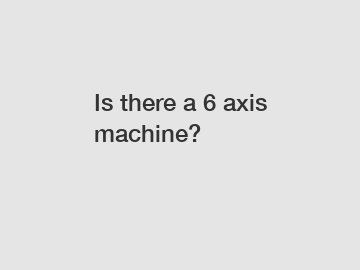Is there a 6 axis machine?
In today's world, the field of robotics has evolved significantly, encompassing a wide range of machines catering to various industrial and consumer needs. From automated assembly lines to assistive devices, these robots come in varying degrees of complexity. However, among the most versatile and agile machines are the 6-axis robots. In this blog, we will explore the fascinating world of 6-axis machines, shedding light on their capabilities, applications, and the impact they have had on industries across the globe.
What is a 6-Axis Machine?
A 6-axis machine, also referred to as a 6-DOF (Degrees of Freedom) robot, is a highly sophisticated robotic arm that can move freely in six different directions. These directions include rotational movements around three perpendicular axes (roll, pitch, and yaw) and translational movements along these axes. This wide range of motion grants 6-axis robots the capability to perform complex tasks with precision and flexibility.

Understanding the Axes:
To comprehend the movements of a 6-axis robot, let's break down the six axes it operates on:
1. Base Axis: This axis allows the robot arm to rotate horizontally, enabling it to cover a significant area.
2. Shoulder Axis: Located at the joint connecting the arm to the base, this axis allows for vertical movement, enabling the arm to extend or retract.
3. Elbow Axis: Situated at the joint between the two arm segments, this axis permits bending and straightening actions.
4. Wrist Roll Axis: Located at the wrist joint, this axis allows for rotational movement, facilitating the roll of the wrist.
5. Wrist Pitch Axis: Also at the wrist, this axis enables the control of up-and-down motion.
6. Wrist Yaw Axis: Lastly, this axis allows for side-to-side rotation at the wrist joint, granting the robot arm increased articulation.
Applications of 6-Axis Machines:
Due to their exceptional range of movements, 6-axis machines find applications in various industries. Let's delve into a few examples:
1. Manufacturing: 6-axis robots revolutionize industrial automation, especially in assembly tasks. With their dexterity, they can handle delicate components with precision, ensuring efficient production lines and consistent product quality.
2. Aerospace: The aerospace industry extensively uses 6-axis machines for tasks like welding, riveting, and component handling. In this industry, the machines' ability to access confined spaces and their high repeatability greatly enhance productivity.
3. Medical: In surgical procedures, where the highest level of accuracy is required, 6-axis machines enable surgeons to perform complex, minimally invasive procedures. Their steady, controlled movements, combined with advanced imaging, facilitate precision surgeries.
4. Research and Development: R&D facilities greatly benefit from 6-axis robots. Engineers use these machines to develop and test prototypes, simulate real-world scenarios, and conduct experiments with a high degree of control and precision.
Challenges and Advancements:
While 6-axis robots offer unmatched versatility, they also pose unique challenges. The complexity in programming and control, along with high costs, limited accessibility, and the need for skilled operators, can be barriers for some industries. However, continuous advancements in robotics, including improved sensors, Artificial Intelligence, and machine learning algorithms, are addressing these challenges and expanding the scope of 6-axis machines.
Looking Ahead:
As automation relentlessly progresses, 6-axis machines are poised to play an even more significant role in various sectors. From intricate medical procedures to precision manufacturing, their robotic arms, mimicking human-like movements, bring exceptional efficiency and reliability. Moreover, with ongoing technological advancements and increased affordability, the accessibility of these machines will continue to grow, making them integral to numerous industries.
Conclusion:
The world of robotics has witnessed remarkable advancements, allowing machines to perform tasks that were once the sole domain of human capabilities. The emergence of 6-axis machines revolutionizes automation, promising unparalleled precision, dexterity, and flexibility. As they become an indispensable part of industries worldwide, 6-axis robots are paving the way for a future where human and machine collaboration is at its most innovative and productive.
For more information, please visit china cnc milling gears, helical gear hobbing, gear hobbing controller.


